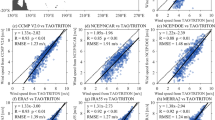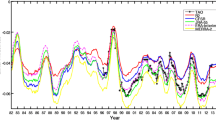Abstract
Outputs from ocean general circulation models driven by different wind data sets, i.e., from satellite measurements (QSCAT) and numerical reanalysis (NCEP/NCAR), are used to examine the dependence of oceanic internal structures in simulated fields on the surface wind input. Comparison between the two simulated fields reveals large differences in the subsurface layers corresponding to the thermocline depth near 100 m along 10°N in the western tropical North Pacific Ocean. These differences, characterized by a 50-m shallower thermocline in this region when simulated using NCEP winds than when simulated using QSCAT, produce discrepancies in the surface current fields of the tropical gyre. Simulated fields are compared to observational ones, including gridded Argo products, sea surface heights from satellite altimetry, and hydrographic measurements along 137°E. Results show that fields simulated using the QSCAT winds are consistent with observed ones in our study area, while those simulated using the NCEP winds exhibit significant differences from the observed fields. A reliable wind product is key to simulating realistic fields at the ocean surface and in the subsurface. Further, the results obtained using a reliable wind product suggest that the Sverdrup relation is applicable to the tropical North Pacific.











Similar content being viewed by others
References
Akima H (1970) A New method of interpolation and smooth curve fitting based on local procedures. J Assoc Comput Mach 17:580–602
Aoki K, Kutsuwada K (2008) Verification of the wind-driven transport in the North Pacific subtropical gyre using gridded wind-stress products. J Oceanogr 64:49–60
Bentamy A, Queffeulou P, Quilfen Y, Katsaros K (1999) Ocean surface wind fields estimated from satellite active and passive microwave instruments. IEEE Trans Geosci Remote Sens 37:2469–2486
Dee DP et al (2011) The ERA-Interim reanalysis: configuration and performance of the data assimilation system. Q J R Meteorol Soc 137:553–597
Giglio D, Roemmich D, Gille S (2012) Wind-driven variability of the subtropical North Pacific Ocean. J Phys Oceanogr 42:2089–2100. https://doi.org/10.1175/JPO-D-12-029.1
Godfrey JS, Golding TJ (1981) The Sverdrup relation in the Indian Ocean, and the effect of Pacific–Indian Ocean throughflow on Indian Ocean circulation and on the East Australian Current. J Phys Oceanogr 11:771–779. https://doi.org/10.1175/1520-0485(1981)011,0771:TSRITI.2.0.CO;2
Gray AR, Riser SC (2014) A global analysis of Sverdrup balance using absolute geostrophic velocities from Argo. J Phys Oceanogr 44:1213–1229. https://doi.org/10.1175/JPO-D-12-0206.1
Hautala SL, Roemmich DH, Schmitz WJ Jr (1994) Is the North Pacific in Sverdrup balance along 24°N? J Geophys Res 99:16041–16052
Hosoda S, Ohira T, Nakamura T (2008) A monthly mean dataset of global oceanic temperature and salinity derived from Argo float observations. JAMSTEC Rep Res Dev 8:47–59
Josey SA, Kent EC, Taylor PK (2002) Wind stress forcing of the ocean in the SOC climatology: comparisons with the NCEP–NCAR, ECMWF, UWM/COADS, and Hellerman and Rosenstein datasets. J Phys Oceanogr 32:1993–2019. https://doi.org/10.1175/1520-0485(2002)032,1993:WSFOTO.2.0.CO;2
Josey SA, Yu L, Gulev S, Jin X, Tilinina N, Barnier B, Brodeau L (2014) Unexpected impacts of the Tropical Pacific array on reanalysis surface meteorology and heat fluxes. Geophys Res Lett 41:6213–6220. https://doi.org/10.1002/2014gl061302
Kalnay EM et al (1996) The NCEP/NCAR 40-year reanalysis project. Bull Am Meteorol Soc 77:437–471
Kameda S, Kutsuwada K (2016) Construction of long-term data set of sea surface wind speed/stress vectors by continuous satellite observations. Int J Remote Sens 37:2032–2046. https://doi.org/10.1080/01431161.2015.1137991
Kameda S, Kutsuwada K (2017) Validation of gridded data set of global surface wind/wind-stress vector field. J Oceanogr 73:585–601. https://doi.org/10.1007/s10872-017-0419-z
Kessler WS, Johnson GC, Moore DW (2003) Sverdrup and nonlinear dynamics of the Pacific equatorial currents. J Phys Oceanogr 33:994–1008. https://doi.org/10.1175/1520-0485(2003)033,0994:SANDOT.2.0.CO;2
Kobayashi S, Ota Y, Harada Y, Ebita A, Moriya M, Onoda H, Onogi K, Kamahori H, Kobayashi C, Endo H, Miyaoka K, Takahashi K (2015) The JRA-55 reanalysis: general specifications and basic characteristics. J Meteorol Soc Jpn 93:5–48
Kubota M, Tomita H (2007) The present state of the J-OFURO air-sea interaction data product. Flux News 4:13–15
Kubota M, Iwasaka N, Kizu S, Konda M, Kutsuwada K (2002) Japanese Ocean Flux Data Sets with Use of Remote Sensing Observation (J-OFURO). J Oceanogr 58:213–225
Kutsuwada K (1998) Impact of wind/wind-stress field in the North Pacific constructed by ADEOS/NSCAT data. J Oceanogr 54:443–456
Kutsuwada K, Morimoto N, Koyama M (2006) Validation study of gridded product of surface wind/wind-stress derived by satellite scatterometer data in the western North Pacific using Kuroshio Extension Observatory Buoy. Proc Pan Ocean Remote Sens Conf 2006:2006
Landsteiner MC, McPhaden MJ, Picaut J (1990) On the sensitivity of Sverdrup transport estimates to the specification of wind stress forcing in the tropical Pacific. J Geophys Res 95:1681–1691. https://doi.org/10.1029/JC095iC02p01681
Large WG, Yeager S (2004) Diurnal to decadal global forcing for ocean and sea-ice models: the data sets and flux climatologies. NCAR Technical Note NCAR/TN-460 + STR. Climate & Global Dynamics (National Center for Atmospheric Research), Boulder
Large WG, Yeager S (2008) The global climatology of an interannually varying air-sea flux data set. Clim Dyn 33:341–364. https://doi.org/10.1007/s00382-008-0441-3
Leetmaa A, Niiler P, Stommel H (1977) Does the Sverdrup relation account for the mid-Atlantic circulation? J Mar Res 35:1–10
Masumoto S (2010) Sharing the results of a high-resolution ocean general circulation model under a multi-discipline framework—a review of OFES activities. Ocean Dyn 60:633–652
Masumoto Y, Sasaki H, Kagimoto K, Komori N, Ishida A, Miyama T, Motoi T, Mitsudera H, Takahashi K, Sakuma H, Yamagata T (2004) A fifty-year eddy-resolving simulation of the world ocean—preliminary outcomes of OFES (OGCM for the Earth Simulator). J Earth Simulator 1:35–56
Masuzawa J, Nagasaka K (1975) The 137°E oceanographic section. J Mar Res 33(suppl):109–116
Meyers G (1980) Do Sverdrup transports account for the Pacific North Equatorial Countercurrent? J Geophys Res 85(2):1073–1075
Munk WH (1950) On the wind-driven ocean circulation. J Meteorol 7:79–93
Nakano T, Kitamura T, Sugimoto S, Suga T, Kamachi M (2005) Long-term variations of North Pacific Tropical Water along the 137°E repeat hydrographic section. J Oceanogr 71:229–238. https://doi.org/10.1007/s10872-015-0279-3
Pacanowski PC, Griffies SM (2000) MOM 3.0 manual. Geophysical Fluid Dynamics Laboratory (National Oceanic and Atmospheric Administration), Princeton
Pickard GL, Emery WJ (1990) Descriptive physical oceanography, an introduction, 5th edn. Pergamon, Oxford, p 320
Ricciardulli L, Wentz FJ (2015) A scatterometer geophysical model function for climate-quality winds: QuikSCAT Ku-2011. J Atmos Ocean Technol 32:1829–1846
Rosatti A, Miyakoda K (1988) A generation circulation model for upper ocean simulation. J Phys Oceanogr 18:1601–1626
Sasai Y, Sasaoka K, Sasaki H, Ishida A (2007) Seasonal and intra-seasonal variability of chlorophyll-a in the North Pacific: model and satellite data. J Earth Simulator 8:3–11
Sasaki H, Nonaka M (2006) Far-reaching Hawaiian Lee Countercurrent driven by wind-stress curl induced by warm SST band along the current. Geophys Res Lett 33:L13602
Sasaki H, Sasai Y, Nonaka M, Masumoto Y, Kawahara S (2006) An eddy-resolving simulation of quasi-global ocean driven by satellite-observed wind field—preliminary outcomes from physical and biological fields. J Earth Simulator 6:35–49
Sasaki H, Nonaka M, Masumoto Y, Sasai Y, Uehara H, Sakuma H (2008) Chapter 10: An eddy-resolving hindcast simulation of the quasi-global ocean from 1950 to 2003 on the Earth Simulator. In: Hamilton K, Ohfuchi W (eds) High resolution numerical modelling of the atmosphere and ocean. Springer, New York, pp 157–186
Schmitz WJ, Thompson JD, Luyten JR (1992) The Sverdrup circulation for the Atlantic along 24°N. J Geophys Res 97:7251–7256. https://doi.org/10.1029/92JC00417
Stommel H (1948) The westward intensification of wind driven ocean currents. Am Geophys Union 29:202–206
Sverdrup H (1947) Wind-driven currents in a baroclinic ocean; with application to the equatorial currents of the eastern Pacific. Proc Natl Acad Sci USA 33(11):318–326. https://doi.org/10.1073/pnas.33.11.318
Thomas MD, De Boer AM, Johnson HL, Stevens DP (2014) Spatial and temporal scales of Sverdrup balance. J Phys Oceanogr 44:2644–2660
Tomita H, Kubota M (2006) An analysis of the accuracy of Japanese Ocean Flux data sets with Use of Remote sensing Observations (J-OFURO) satellite-derived latent heat flux using moored buoy data. J Geophys Res 111:C07007. https://doi.org/10.1029/2005JC003013
Tomita H, Hihara T, Kako S, Kubota M, Kutsuwada K (2018) An introduction to J-OFURO3, a third-generation Japanese Ocean Flux Data Set Using Remote-Sensing Observations. J Oceanogr (submitted)
Woodruff SD, Slutz RJ, Jenne RL, Steurer PM (1987) A comprehensive ocean-atmosphere data set. Bull Am Meteorol Soc 68:1239–1250
Wunsch C (2011) The decadal mean ocean circulation and Sverdrup balance. J Mar Res 69:417–434. https://doi.org/10.1357/002224011798765303
Wunsch C, Roemmich D (1985) Is the North Atlantic in Sverdrup balance? J Phys Oceanogr 15:1876–1880. https://doi.org/10.1175/15200485(1985)015,1876:ITNAIS.2.0.CO;2
Yuan D, Zhang Z, Chu PC, Dewar WK (2014) Geostrophic circulation in the tropical North Pacific Ocean based on Argo profiles. J Phys Oceanogr 44:558–575
Acknowledgements
The authors would like to thank Drs. Masahisa Kubota and Yukio Masumoto for helpful discussions and advice on this study. We thank Dr. Toshiya Nakano for providing the hydrographic data along 137°E of JMA. We also wish to acknowledge the use of the FERRET program, NOAA’s Pacific Marine Environmental Laboratory, for the analysis and graphic plots used in this paper. Further, we thank the anonymous reviewers whose useful comments helped to improve our original manuscript. The OFES simulations were conducted using the Earth Simulator with the support of JAMSTEC. The scatterometer dataset (QuikSCAT/SeaWinds) used in J-OFURO2 was kindly provided by the NASA Physical Oceanography Distributed Active Center (PO.DAAC) at the Jet Propulsion Laboratory. Parts of this study were financially supported by the Japan Aerospace Exploration Agency and the Institute of Oceanic Research and Development, Tokai University, Japan.
Author information
Authors and Affiliations
Corresponding author
Rights and permissions
About this article
Cite this article
Kutsuwada, K., Kakiuchi, A., Sasai, Y. et al. Wind-driven North Pacific Tropical Gyre using high-resolution simulation outputs. J Oceanogr 75, 81–93 (2019). https://doi.org/10.1007/s10872-018-0487-8
Received:
Revised:
Accepted:
Published:
Issue Date:
DOI: https://doi.org/10.1007/s10872-018-0487-8




